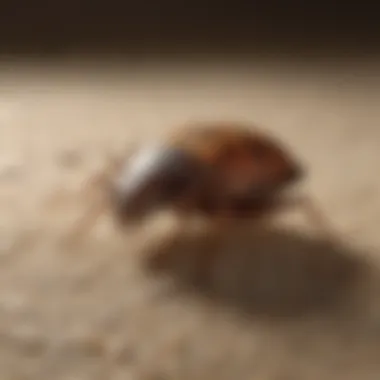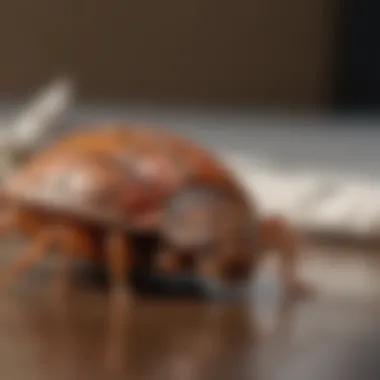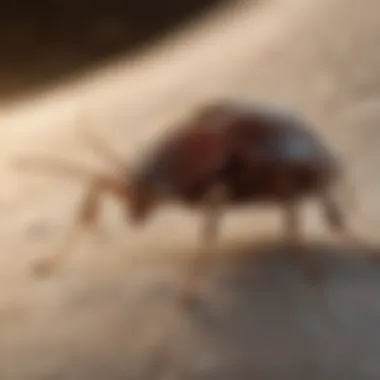Exploring the Efficacy of Smells in Bed Bug Management


Preventive Pest Control Strategies
Bed bugs are, as many homeowners know, persistent pests that can significantly disturb your peace at home. Managing these intruders often begins with preventive strategies that emphasize exclusion and cleanliness. Taking steps to fortify your living space not only reduces the risk of infestation but also facilitates ease when pest control measures become necessary.
House Exterior Protection
Keeping bed bugs out begins on the outside. A well-protected house can deter various pests from gaining entry. Here are some vital measures you can take:
Tips for sealing cracks
Inspect your home's exterior for cracks and openings where bugs can enter. Techniques like caulking gaps around windows and doors, filling in cracks in walls with suitable materials will close those access points.
Clearing debris
Piling up leaves, firewood, or clutter attracts different pests. Maintain neat yards and remove debris where pests could live. Regular maintenance decreases the chance of pest attraction right outside your home.
Preventing pests from entering
Ensure screens for windows and doors fit snugly. Utilizing self-closing devices or weather stripping can block entryways efficiently.
Yard Maintenance
Protecting your yard is also essential for pest prevention. An inviting yard leads to inviting your home as well important yard care routines include:
Essential yard care routines
Regular mowing, watering as needed, and keeping plants trimmed allow for sunlight penetration. Thorough weeding keeps not only plants healthy but areas devoid of shelter for undesirable pests.
Methods for keeping yard pest-free
Incorporate natural deterrents. Certain plants, such as marigolds or citronella, had proven scents to repel pests. Placement governs their effectiveness considerably.
Indoor Cleanliness
A clean indoors directly relates to pest deterrence. Unmaintained indoor environments become centres for infestation. Following expert cleaning tips with care can counteract many risks:
Expert cleaning tips and techniques
Focus on thorough vacuuming, especially in tight areas like edges and underneath furniture. Regular washing of bedding and linens with hot water disrupts any existing eggs or pest presence significantly.
Maintaining a pest-resistant indoor environment
Consider removing clutter and utilizing sealed containers for storage. This practice provides fewer hiding places for bugs. Regular check-ups on supplies minimize pests concealed in food items as well.
Garbage Disposal
Proper waste management promotes health and comfort rather than undesired invite for pests. Efficient garbage disposal and its management remains essential. Here’s how:
Efficient waste disposal methods
Frequent and proper disposal collected trash limits attractant availability for pests. Utilize bins with tight-fitting lids that obstruct access and scents escape.
Importance of proper garbage disposal
Ensuring appropriate measures here deters many pests. Bugs like bed bugs are clever and efficient in seeking their nourishment, and rubbish offers much they desire.
Other Pest Prevention Strategies
Beyond typical precautions, explore distinct methods of safeguarding your home.
Innovative ways to safeguard your home
Try employing barriers or dull-ing scents through odor-dispersing agents that bed bugs and others shy away. Smart technology in pest control provides efficient tools and proactive options.


“Preventative steps limit the inherent risks of pest invasion while ensuring a comfortable space at the same time.”
Communicating with pest control professionals about specific risk factors unique to your residence can lead to tailored strategies appropriate to your needs. Being vigilant in these areas assists any effort in maintaining your household against bothersome bed bugs and other pests.
Prolusion to Bed Bugs
Understanding bed bugs and their behavior is crucial when seeking effective management strategies. This section will provide insight into what these pests are, their life cycle, and the impact they have on our lives. This knowledge is fundamental when exploring how certain smells may offer practical solutions.
Understanding Bed Bug Behavior
Bed bugs are small, nocturnal insects that feed on the blood of humans and animals. Their flattened bodies allow them to hide easily in small crevices near their feeding sources. They are particularly adept at sensing body heat and carbon dioxide, which lead them to their hosts.
Bed bugs possess a unique mating ritual and can reproduce quickly, with a single female laying up to five eggs each day. A key factor in their infestation ability is their capacity to go without food for several months. This resilience can make eradicating bed bugs quite difficult. Moreover, they primarily spread through human activity, often hitching rides in luggage or clothing. Understanding these aspects is vital to effective pest management strategies.
Impact of Bed Bugs on Human Well-Being
The presence of bed bugs can greatly affect human well-being. Their bites typically cause itchy welts, which can lead to significant discomfort. In some cases, allergic reactions can occur, resulting in more serious health issues.
Beyond physical effects, the psychological toll can be substantial. Bed bug infestations often cause anxiety and sleep disturbances. The stigmatization associated with these pests can breach personal boundaries within homes and public spaces, making people feel uncomfortable and violating their sense of security in their living environments.
According to the CDC, bed bugs can lead to stress and loss of sleep, which can negatively affect one’s overall health.
In summary, bed bugs pose a serious threat not only to comfort but also to psychological and physical health. This foundational understanding sets the stage for further discussion on employing smells as a method for managing these pests effectively. Through recognizing the behaviors and impacts of bed bugs, individuals can better appreciate the potential non-chemical options available for control and eradication.
Chemical Signals and Insects
Understanding the chemical signals that influence insect behavior is key in addressing the problem of bed bugs. Bed bugs rely on pheromones and other chemical cues for communication, navigation, and reproduction. By exploring these mechanisms, we can better comprehend potential methods for repelling or managing these health and comfort nuisance.
Chemical signals act as a language for insects. They convey necessary information about surroundings, dangers, and even potential mates. Understanding this form of communication helps in developing strategies that can disrupt their habits and diminish their populations. This approach, when combined with traditional pest control methods, may yield more effective results.
Consider the implications of using chemical signals in pest management:
- Namely, identifying specific odors that trigger repellent responses can help in both commercial and residential settings.
- Creating confusion among bed bugs by employing certain scents may minimize their breeding and shelter-seeking behaviors.
- Fostering health-conscious environments becomes achievable as fewer chemical insecticides may be needed.
This exploration of chemical signals within bed bugs promotes a harmonious coexistence of effective pest control and health safety.
Overview of Pheromones
Pheromones are fascinating substances in the world of insects, acting as a primal means of connection among them. For bed bugs, pheromones serve functions ranging from marking territories to signaling danger. The detection of these odorous chemicals by bed bugs significantly impacts their behavior.
Bed bug pheromones can be categorized into several types:
- Aggregation Pheromones: These are signals that attract other bed bugs to a specific location, often their food source.
- Alarm Pheromones: Released when bed bugs sense danger, causing others to scatter and escape potential threats.
- Sex Pheromones: These signals are emitted during mating periods, attempting to entice potential mates based on specific scent profiles.
Understanding these pheromone types is crucial in designing effective repellent strategies. Research points toward the possibility of utilizing synthetic or natural compounds to disrupt these signals, thus influencing bed bug interactions.
Olfactory Sensitivity in Bed Bugs
The extent of olfactory sensitivity in bed bugs is remarkable. Their ability to detect and respond to various odors allows them to find food sources, mates, and suitable hiding places. This sensitivity signifies a primary opportunity to integrate scents into pest control methodologies.
Studies indicate that bed bugs can detect chemicals at remarkably low concentrations. They possess a unique set of olfactory receptors that enables this keen detection. Factors to consider about their olfactory prowess include:
- Diversity in Responding: Bed bugs show varied reactions based on different scents. Natural repellents may succeed where synthetic chemical products falter.
- Behavior Modulation: Exposure to specific odors influences behaviors significantly. The deployment of certain essential oils could deter bed bugs from invading spaces.
With our knowledge of bed bugs' olfactory sensitivity, it becomes plausible to craft effective strategies incorporating scents. This not only diversifies pest control options but also promotes a deeper comprehension of how we can utilize scents in managing these pests effectively.
Evaluating Common Odors
Evaluating common odors is a critical aspect of the study on bed bug management. Bed bugs, as stubborn pests, often require inventive strategies for control. Traditionally, chemical insecticides have dominated the market. However, there is a noticeable shift towards more natural methods, driven by concerns around toxicity and environmental impact. Understanding how various scents can repel bed bugs can offer householders readily available and safer alternatives. This approach helps to integrate sensory interactions into pest control strategies, creating a more holistic method.
In the sections below, we will explore various scents, focusing on essential oils and household items that serve as effective repellents. Each type of odor not only showcases unique properties, but also highlights diverse applications that can suit different preferences and environments.
Essential Oils and Their Properties


Essential oils are natural extracts known for their fragrant and therapeutic qualities. In the context of bed bug management, these oils gain focus because they may emit scents potent enough to repel these pests. Additionally, they provide a non-toxic solution, which is ideal when considering environments inhabited by children or pets.
Tea Tree Oil
Tea tree oil stands out for its reputed antimicrobial properties. This key characteristic makes it a viable option for managing bed bugs while also promoting a clean atmosphere. Studies suggest that the scent emitted from tea tree oil can disrupt bed bug behavior, driving them away from infested areas.
One unique feature of tea tree oil is its dual-purpose nature. It can repel pests while also functioning as a minor antiseptic. While widely regarded as beneficial, the properties of tea tree oil can be volatile if not properly diluted. Careful application methods are crucial in avoiding any skin irritation that could arise from its use.
Lavender Oil
Lavender oil has long been celebrated for its calming properties. Its soothing scent is appealing to many, adding to its popularity. In bed bug management, lavender oil shows effectiveness in repelling insects due to the natural compounds it contains.
The key characteristic of lavender oil is its ability to create a peaceful environment while discouraging bed bugs. Something important about lavender is its minimal side effects. While beneficial for people, it may not provide a strong enough deterrent under extreme infestations. Nonetheless, its multifaceted nature makes it a solid choice for incorporating within a broader pest management strategy.
Peppermint Oil
Peppermint oil is recognized for its refreshing scent. This oil serves as an effective insect repellent, showcasing strong efficacy against bed bugs. The strong menthol scent often triggers repulsion in insects, including the notorious bed bug.
A notable characteristic of peppermint oil is its invigorating aroma, which makes it a favorable choice among households that use it regularly. Its unique feature lies in quick accessibility. This oil can easily integrate into common cleaning regimens. However, the potent nature of peppermint can harm sensitive individuals if overused. Ensuring balanced application guidelines would help maximize its desired benefits.
Household Items as Natural Repellents
Household items present an appealing alternative to commercial insect repellents. Many common substances possess properties that can repel bed bugs effectively. These options are accessible, budget-friendly, and safer for homes.
Vinegar
Vinegar, an essential kitchen staple, is praised for its versatility. Its efficacy as a bed bug repellent is notable, primarily due to the strong smell it generates. The powerful scent serves as a natural deterrent against bed bugs, making its use well supported.
Its advantage lies in availability; vinegar is commonly found in homes, making it an easy choice for timely interventions. However, vinegar’s effectiveness might vary from case to case. While some reports document success, its potency alone may not suffice for heavy infestations. Homeowners should consider supplementing vinegar with other materials for an enhanced strategy.
Citrus Fruits
Citrus fruits, particularly lemons and oranges, embody pleasant fragrances that can inhibit bed bugs. The presence of citric acid creates a natural barrier, making them uninviting to pests. As a positive characteristic, they bring freshness and aroma to infested areas.
However, using citrus fruits as repellents can come with constraints. Although beneficial and aromatic, the effect tends to be less immediate compared to concentrated oils. Constant reapplication might be necessary for optimal outcomes. This course of action could deter pest resurgence in conjunction with preventive measures.
Garlic
Garlic operates as a strong repellant owing to its odorous nature. The pungent smell can act as a natural barrier, which bed bugs tend to avoid. As a commonly used ingredient in kitchens, its application in pest control strategies aligns well with adjustments that homeowners already practice.
One key aspect of garlic is its ease of accessibility and widespread use. many individuals may already have surplus cloves at hand. On the downside, its offensive aroma might linger disproportionately in the home. Thus balancing quantity is essential, ensuring garlicky odors do not become burdensome within living environments.
Ultimately, the exploratory focus on essential oils and household items underscores the practicality of integrating specific odors into effective pest management strategies. The importance and dynamism displayed through these approaches reveal the opportunity of approaching bed bug control from multiple angles.
Scientific Studies on Odor Repellency
The investigation of odor repellency plays a significant role in developing non-toxic strategies to manage bed bug infestations. As health concerns rise around chemical insecticides, many researchers have turned their attention to natural alternatives. Understanding how specific scents interact with bed bugs allows us to identify effective methods for repellent behavior. The importance of these studies lies in their potential to offer solutions that are not just efficient but also environmentally friendly.
Research Findings on Essential Oils
Essential oils are derived from various plant sources and have garnered attention due to their natural insecticidal properties. A number of studies conducted have demonstrated how certain essential oils repel bed bugs. For example, research shows that oils such as peppermint, tea tree, and lavender possess compounds that disrupt bed bug behavior. In controlled environments, these oils created a barrier, which prevents bed bugs from approaching host surfaces assumed to be infested.
Their potency can vary based on concentration and application method.
- Peppermint Oil: Studies indicate this oil emits strong odors, which bed bugs tend to avoid.
- Tea Tree Oil: Found effective in preventing the body-sized contact that typically occurs during infestation.
- Lavender Oil: Acted not only as a deterrent but also contributed to bed bug mortality in certain settings.
Strikingly, these findings suggest that compositional variance in essential oils can yield different results in repelling behavior. For home use, incorporating these smell profiles in pest control can offer resilience against these pervasive pests without the harm that often accompanies standard pesticides.
Effectiveness of Vinegar and Citrus Scents
Vinegar and citrus are two kitchen staples frequently mentioned in discussions about home remedies for pests. Research supports the notion that these readily available substances contribute to bed bug repelling.
- Vinegar: Its acetic acid content has proven effective in deterring various insects, including bed bugs. Laboratory tests show a marked dislike of the scent, causing bed bugs to retreat from zones treated with vinegar.
- Citrus Scent: With essential components like d-limonene, citrus scents provoke avoidance behavior from bed bugs. Specific studies had to track insect movements, revealing a clear trend of leftward movement, steering away from sprayed areas.


It is crucial to mention the practical attributes of using vinegar and citrus juices—they offer easy application, are safe for humans and pets, and promote an environmentally sustainable approach.
Reserach discoveries on odor repellency allow both homeowners and scientists to rethink pest control for better efficacy and safety. By valuing natural over synthetic methods, a balance is achievable in household pest management.
Practical Applications of Odor-Based Solutions
The incorporation of odor-based solutions into bed bug management strategies holds significant promise, not only for the integrity of pest control methods but also for maintaining human health and comfort. Utilizing certain smells can transform the way household environments resist bed bug invasions. Therefore, combining these techniques with established practices could enhance overall efficacy. Everyday household items can serve as a means of both prevention and control.
Incorporating Odors into Pest Control Strategies
Integrating specific scents into pest control инициатив is an innovative approach that offers distinct advantages. Firstly, many essential oils provide a dual benefit. They not only repel bed bugs but also offer pleasant fragrances, which can uplift the atmosphere of your space. Calendula oil, for instance, is revered for its antifungal properties, creating an aromatic deterrent that can inhibit pest populations.
To effectively incorporate these odors:
- Identify Key Odors: Focus on essential oils like tea tree oil and lavender oil, which studies demonstrate have repellent effects against bed bugs.
- Application Methods: Introduce these scents into your environment via sprays or diffusers. Natural homemade sprays with odors can be generously applied to cracks, bedding, or high-risk areas.
- Consistency: Regular application enhances the persistence of the odor, ensuring continuous pest deterrence. Best practice is to repeat treatments every few days and observe changes.
Employing these aromas not only creates a less inviting landscape for bed bugs but also promotes healthier indoor air quality, enhancing comfort levels.
Limitations and Considerations
However, despite their myriad benefits, odor-based solutions have certain limitations that users must be aware of. While essential oils can repel bed bugs, their success is highly dependent on concentration and method of application. Carefully consider the following:
- Variability in Effectiveness: Not all essential oils may be equally effective. Individual sensitivity, environmental factors, and species variations can change outcomes.
- Short-Term Benefits: Many natural scents tend to have temporary effects that require repeated application, meaning they can fall short as long-term solutions.
- Potential Allergens: Essential oils may trigger allergic reactions in some individuals. It is prudent to perform a patch test before extensive application.
- Incomplete Control: Relying solely on odors should not be a substitute for thorough pest control methods. Instead, they should complement standard strategies, especially in severe infestations.
Balancing scent-based prevention with strong eradication techniques is essential for maintaining effective pest management practices.
By understanding both the practical applications and limitations associated with these smell-based tools, households can better arm themselves against potential bed bug problems, optimizing their environments for comfort and safety.
Comparison with Chemical Insecticides
When exploring methods to combat bed bugs, a significant consideration arises in the comparison with chemical insecticides. Traditional insecticides have proven effective in controlling these pests, yet they come with various drawbacks. Many homeowners express concerns over the potential health risks associated with chemical exposure. Children, pets, and individuals with sensitivities are particularly vulnerable. Moreover, there is growing awareness of environmental impacts. Therefore, it is vital to compare chemical insecticides with alternative methods such as odor-based repellents.
The efficacy of chemical insecticides often hinges on their active ingredients, with some showing robust effectiveness against bed bugs when applied correctly. However, repeated exposure can lead to resistance, making insects harder to eliminate over time. Therefore, integrating odor-focused strategies could offer alternative approaches alongside traditional methods. Homeowners seek solutions that emphasize safety, reduce chemical footprints, and maintain efficacy. Evaluating potential benefits and risks of both options supports informed decisions that can better suit individual health and environmental concerns.
Risks and Benefits
Insecticides come with important risks such as detrimental health effects post-application. Nausea, dizziness, and, in extreme situations, chemical poisoning may result from improper use or persistent exposure. Additionally, understanding the nuances of chemical resistance proves essential. Overuse often leads to the pests developing resilience against certain chemical agents.
Despite these challenges, chemical insecticides deliver significant benefits with immediate action against infestation. Their systematic testing provides confidence in specific dosage forms. Accordingly, many users find value in their swift results. Nevertheless, these benefits pose heightened risks in scenarios where reliant use continues unchecked.
Odor-based pest control alternatives timeline offers a diversified solution without these substantial pitfalls. Research shows essential oils like lavender and tea tree oil demonstrate promising repellent effects, which may assist in curtailing bed bug populations diverging away from an insecticidal approach.
Sustainability of Using Odors
Examining sustainability offers insight into the broader picture regarding pest solutions. In a landscape where more individuals value eco-friendly practices, employing odors as repelents proves advantageous. Natural scents rarely elicit acute side effects in humans. They often harness the concentrated properties from plants known not only to warn off bugs but add a pleasant fragrance to living environments.
Odor-based methods carry lesser environmental consequences, marking a change towards sustainable options. Studies reveal alternative approaches lead to a gradual you can frequent reduce bed bug populations. Within comming moral confines of chemicals present systematic over usage concern sustainability become major topic.
The lifecycle impacts of traditional pesticides often showcase excessive depletion on local ecosystems. Thus, integrating odors into standardized control methods swiftly emphasizes an emerging bond towards improvement of practice.
Epilogue
In this section, we delve into the significance of utilizing smells in bed bug management. This article highlights how scents inadvertently become a valuable ergonomic in the ongoing battle against pests. Recognizing the importance of odor-based solutions is essential, particularly for residential settings that struggle with infestations. Whether through essential oils, household items, or other natural repellents, understanding these methods provides householders with improved strategies.
Summary of Findings
The findings of this exploration reveal that various scents show promise in repelling bed bugs:.
- Essential oils like tea tree, lavender, and peppermint have demonstrated notable effectiveness.
- Common household itens, such as vinegar, citrus fruits, and garlic, serve as potential natural deterrents against these pests.
Research consistently indicated that bed bugs exhibit a varied response to specific odors. This sensitivity underscores the potential for incorporating smell-based tactics into broader pest control measures. Notably, integration of natural smells offers an alternative approach that aligns with a burgeoning focus on sustainable pest management, reducing the reliance on chemical insecticides that may pose health risks
The successful employment of odor strategies depends on understanding both their effectiveness and limitations.
Future Directions in Research
Next steps for the research community should foster deeper investigations into odor efficacy as a bridge between traditional methods and innovative alternatives. Key areas warranting exploration include:
- Mechanisms underlying olfactory sensitivity in bed bugs. Understanding the biology can yield insights.
- Synergistic effects, analyzing the combinations of different smells may enhance pests' repellent abilities.
- Field trials encompassing curated scent applications in various environments to clarify results beyond controlled laboratories.



